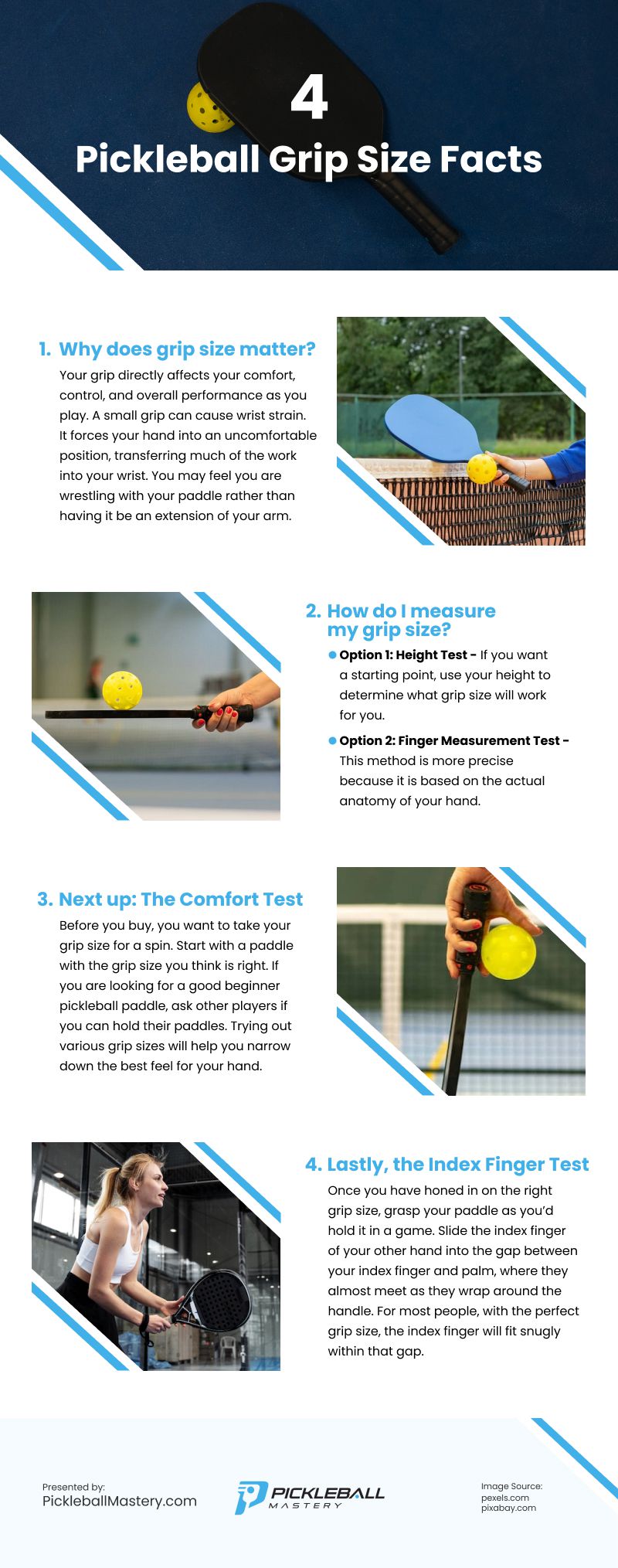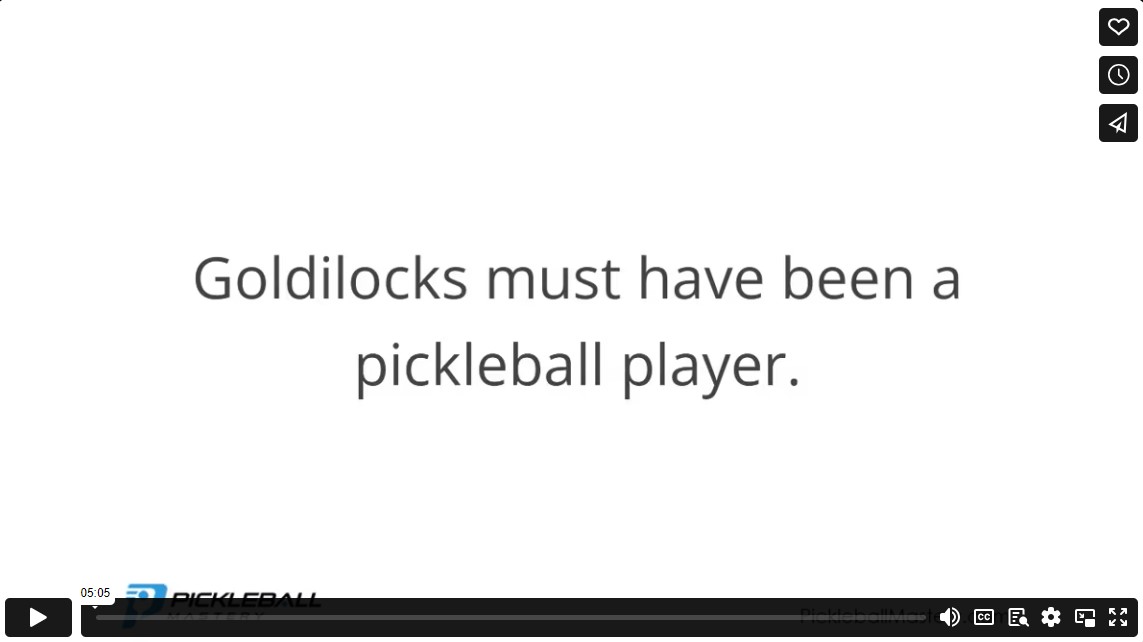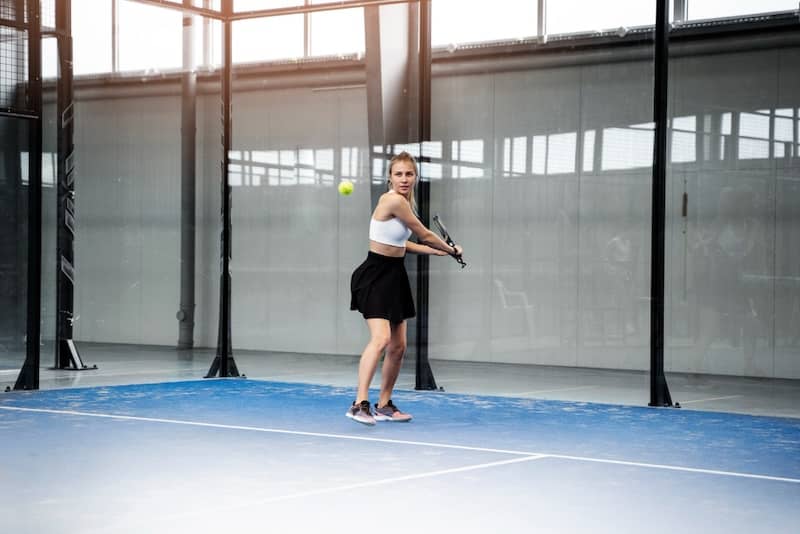Goldilocks must have been a pickleball player. “This grip is too small. This grip is too big. This grip is just right.” Like the fair-haired, porridge-thieving, chair-breaking girl in the fairy tale, you may struggle to find a pickleball paddle that is a comfortable fit. Discovering the right grip size is like unlocking a magical world. Suddenly, the birds sing. You feel like Cinderella dressed in her gown and glass slippers or Peter Pan in his beloved Neverland. But you don’t need a fairy Godmother or a tink-ing pixie to find the correct pickleball grip size.
Grab your pickleball paddle, and let’s embark on a journey to find your pickleball grip version of happily ever after.
Why does grip size matter?
The right shoe for one is a nightmare for someone else. The same goes for pickleball grips.
Your grip directly affects your comfort, control, and overall performance as you play. A small grip can cause wrist strain. It forces your hand into an uncomfortable position, transferring much of the work into your wrist. You may feel you are wrestling with your paddle rather than having it be an extension of your arm.
A grip that is too large can cause your paddle to feel unwieldy. You may struggle for precise control and end up sending what you intended to be a deep shot past the baseline. Point to your opponents. Imagine trying to play in shoes that are three sizes too big. You will be awkward and uncomfortable no matter how skilled or fancy your footwork is.
That’s why grip size matters. It dictates how the pickleball paddle feels in your hand and how well you control your swing. With the proper grip, your paddle becomes an extension of you, expertly sending the ball to exactly the right spot on the court with the right spin, drop, and curve.
How do I measure my grip size?
There are two methods for determining what grip size will work best for you.
Option 1: Height Test
Since you probably know your height, this is the easiest way to find your appropriate grip size. However, this method isn’t perfect because short people can have large hands, and tall people can have stubby fingers. Still, it can give you a great place to start. Here’s how height and grip size relate:
- If you are under 62 inches tall, try a four-inch grip.
- For those 63 to 68 inches, start with a four-and-a-quarter-inch grip.
- Those 69 inches or taller will likely want a four-and-a-half-inch grip.
The height test method works for both men and women. If you want a starting point, use your height to determine what grip size will work for you. You’ll likely prefer the smaller grip if your height falls between those height categories.
Option 2: Finger Measurement Test
This method is more precise because it is based on the actual anatomy of your hand.
Spread your fingers wide on your dominant hand. Locate the middle crease of your palm. That’s the line between the crease that curves around your thumb and the one that runs directly underneath your fingers. The middle crease is the one you want. Fun fact: in palm reading, this is known as the head line. And you can use it to get ahead in your pickleball game by finding the correct grip.
Measure from that line to the tip of your ring finger. That measurement should correspond with your grip size. You may prefer a slightly smaller grip or, in some cases, a larger one. But this hand measurement will correspond with most people’s most comfortable grip size.
In Between Sizes?
3 ¾ inches? 4 ⅜ inches? Just because your hand measurements don’t align with the most common, standard grip sizes doesn’t mean you are an ugly duckling. Most manufacturers of pickleball paddles are well aware that some of us can’t be constrained by traditional categories and expectations. Many paddles are available with circumferences outside those standard options to address differences in hand size and grip preferences. Professional pickleball paddles may even be fitted with custom grips, allowing players to tailor their paddle grip to fit their hand exactly.
Next up: The Comfort Test
Okay, you’ve taken the measurements and know what the charts recommend. Before you buy, you want to take your grip size for a spin. Start with a paddle with the grip size you think is right. If you are looking for a good beginner pickleball paddle, ask other players if you can hold their paddles.
Grip the paddle. Does it feel like you are straining to get a secure hold? Do you feel you have to squeeze too tightly to maintain control? What happens when you take a few test swings? The paddle should feel like an extension of your hand, not a growth you must control.
Hold the paddle out in front of you, like you are reaching to shake hands. Wiggle your hand up and down. Does the grip still feel secure?
Trying out various grip sizes will help you narrow down the best feel for your hand.
Lastly, the Index Finger Test
Once you have honed in on the right grip size, grasp your paddle as you’d hold it in a game. Slide the index finger of your other hand into the gap between your index finger and palm, where they almost meet as they wrap around the handle. For most people, with the perfect grip size, the index finger will fit snugly within that gap. If the fingers on your grip hand almost touch your palm, your paddle grip may be too small. If that gap is much broader than your index finger, try a smaller grip.
Remember, all of these are just guidelines. They give you a place to start, but your comfort and control are the most critical factors. You should play with the grip size that feels best in your hand when swinging your paddle and hitting the ball.
Armed with the knowledge of your ideal grip size, you can conquer dragons. Or if not dragons, then at least your Aunt Mildred’s friend’s pickleball doubles partnership. You and your new, just-right pickleball grip can ride off into the sunset together, playing happily ever after.
Video
Infographic
Discover the correct grip size for your pickleball paddle to enhance your playing experience. Take your pickleball paddle and find your perfect grip with this infographic.





